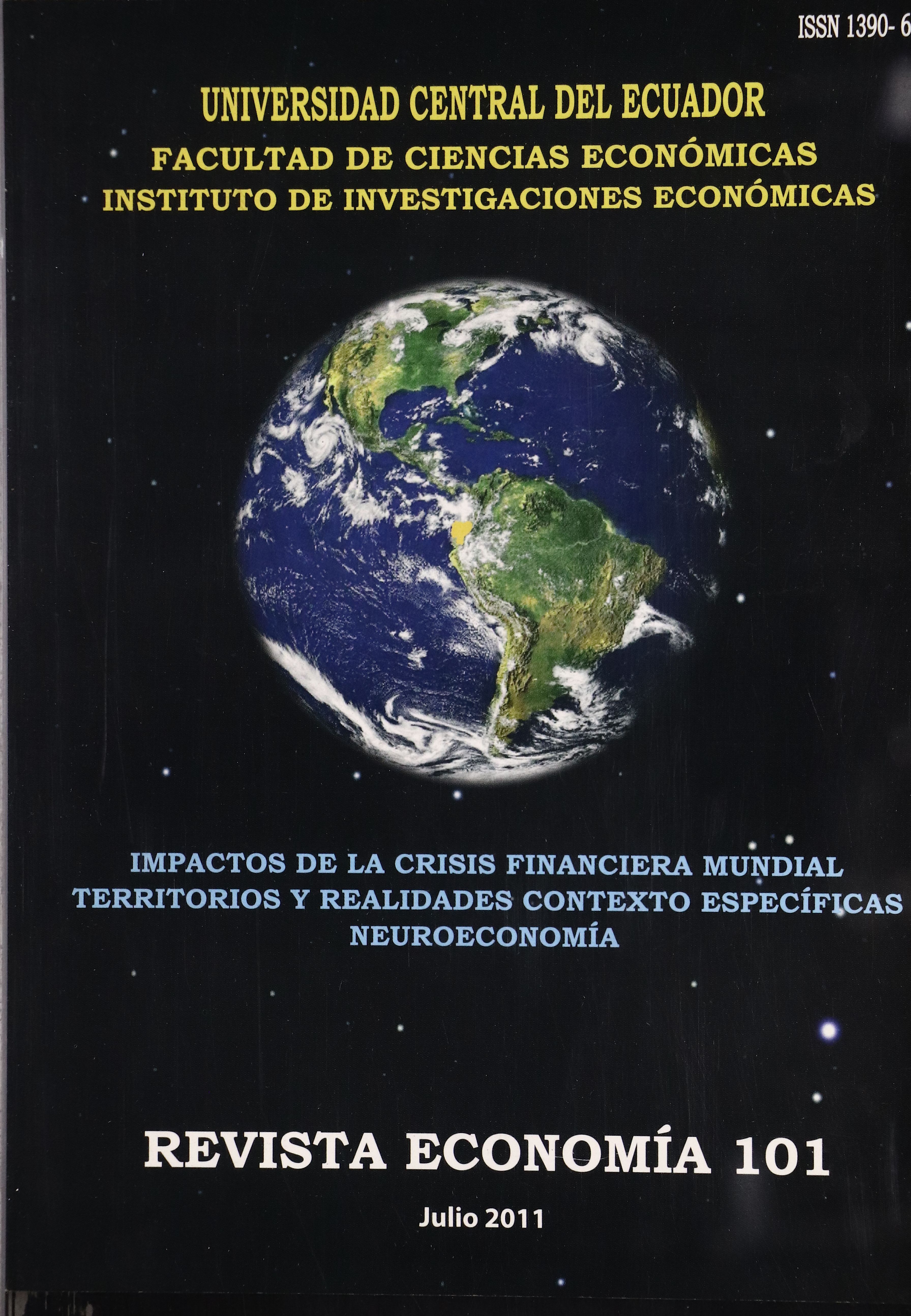Relación entre innovación, gestión del conocimiento y la competitividad productiva en Ecuador
Main Article Content
Abstract
Of the Latin American countries, Ecuador traditionally has an economic system of private production, where most of the investment is, the State has been weak, in the context of the global economy. The economic policy of the governments is materialized in the development plans, where the thinking of the governments and political parties is reflected, in the economic sectors that are oriented to investment, so that they generate the greatest populist impacts as a clientelist group, so our economy is complementary and not competitive.
Downloads
Article Details

This work is licensed under a Creative Commons Attribution-NonCommercial 4.0 International License.
The authors who publish in this journal accept the following conditions:
- The authors retain the copyright and assign to the Economics Magazine the right of the first publication, with the work registered under Creative Commons Attribution-NonCommercial 4.0, which enables third parties to redistribute, commercial or non-commercial, of what has been published as long as the article circulates completely and without changes.
- Authors can make other independent and additional contractual agreements for the distribution of the article published in this journal (for example, add it to an institutional repository or publish it in a book) as long as they clearly and clearly specify that the article was published for the first time. once in Revista Economía. In case of reproduction, a note similar to the one presented below must be included: This text was originally published in the Revista Economía No.…, volume…, number of pages, year of publication.
- Authors are suggested to publish their work on the internet (for example, on institutional or personal pages) of the final version published by Revista Economía since this can lead to greater and faster dissemination of the published article.
References
Arrow, K. (1962). “Economic Welfare and the Allocation of Resources for Invention”, en Nelson, R. (ed.) “The Rate and Direction of Inventive Activity”. Pinceton University Press.
Audretsch, D. (1995). "Innovación and Industry Evolution”. The MIT Press. Cambridge, Mass.
Audretsch, D. y Feldman, M. (1996). “R+D Spillovers and the Geography of Innovation and Production”. American Economic Review, 86 (3).
Bain, J.S. (1968), Industrial Organización, John Wiley, Nueva York.
Benhabib, J. y Jovanovic, B. (1991). “Extemalities and growth accounting”. America Economic Review, 81.
Blanco, C., (2004), “La Gestión del Conocimiento en las empresas intensivas en tecnología en los parques tecnológicos vascos y el impacto en el rendimiento: Tesis doctoral, Universidad de Deusto, España.
Cainelli, G., Evangelista, R. y Savona, M. (2003). “The Impact of Innovation on Firms Growth and Productivity in Italian Services”. Trabajo presentado al International Workshop “Empírica] Studies on Innovation in Eurpope”. Universitá delgi Studi di Urbino.
Cimoli, M. y Katz, J. (2001). DRUID's Nelson and Winter Conference Aal-Borg.
Cohén W. And Levinthal, D. (1989). “Innovation and Leaming: The Two Faces of R+D”. Th Economic Journal, 99 (3).
Choo, Wei. (1999) La organización inteligente. El empleo de la información para dar significado, crear conocimiento y tomar decisiones, Oxford, México.
Daventport.T. y Prusak, L. (2000), trabajando con el conocimiento: cómo las organizaciones administran lo que ellas conocen. McGarw Hill. España.
Earl, L. (2003). “Are We Managing our Knowledge?”. OECD/Ministry of Industry, Cañada.
Edler, J. (2003). “The Management of Knowledge in Germán Industry”. OECD/Ministry of Industry, Cañada.
Edvinsson, I. y Malone, M. (1997) El capital intelectual. Gestión 2000, Barcelona,
Grilliches, Z. (1979). “Issues in Assessing the Contribution of R+D to Productivity Growth". Bell Journal of Economics, 100.
Grossman, G. y Helpman, E. (1991). “Innovation and Growth in the Golbal Economy”. The MIT Press. Cambridge; Mass.
Gruber, W.H., Mehta, D. Y Vemon, R. (1967). “The R+D Factor in International Trade and International Investment of the United States”. Journal of Political Economy,
Jaffe, A. (1986). “Technological Opportunity and Spillovers of R+D: Evidence fforn.
Firms'Patents, Profits and Market Valué”. Amercian Economic Review, 76.
Keesing, D.B. (1967). “The Impact of Research and Development on United States Trade”. Journal of Political Economy”
Kremp, E. y Mairasse J. (2004). “Knowledge Management, Innovation and Productivity: A Firm Level Exploration Based on French Manufacturing CIS3 Data”. NBER WorkingPaper W10237
Krogh, V, Ichijo G., K. y Nonaka, I, (2001), “Facilitar la Creación de Conocimiento” Oxford University Press.
Link y Rees (1990). “Firm Size, University Based Research and the Retums to R&D”. Small Business Economics, 2(1).
Masom, E.S. (1957), Economic Concentration and the Monopoly Problem, Harvard University Press, Cambridge, Massachussets.
Mcadan, R y Reid, R. (2001),” SME and Large organisation of Knowledge management: comparisons and Contrasts. Journal of Knowledge Management, Volume 5,Number3.
Nonaka, I. y Takeuchi, H. (1995), The knowledge creating company: how Japanese companies create the dynamics of innovation, Oxford University Press, Oxford.
Pavitt, K. (1990). “What We Know About the Strategic Management of Technology”. Research-Technology Management 44(2):25-36.
Pase ale, Ricardo. (2005) Gestión del conocimiento, innovación y productividad. Exploración del caso de la industria manufacturera uruguaya. Internet Interdisciplinary Institute, En: http://www.uoc.edu/in3/dt/esp/pascale0605 html (consultado, 7 de enero de 2010).
Pérez, C. (1996). “El cambio de paradigma en las empresas como proceso de cambio cultural”. Trabajo presentado a ALTEC, Octubre. México D.F.
Pérez, C. y Soete, L. (1988). “Catching up in Technology: Entry Barriers and Windows of Opportunity”. En Dosi et al Technical Change and Economic Thepry. London: Printer.
Rivero, Santiago. (2002). Claves y pautas para comprender e implantar la gestión del conocimiento. Fundación
Escuela de Ingenieros de Bilbao - Socintec, Madrid.
Romer, P. (1990). “Endogenous Technological Change”. Journal of Política] Economy, 98.
Senge, Peter, (1999). La quinta disciplina. Granica, Barcelona.
Schein, Edgar, (1980). Organizational Psycology, Prentice Hall, New Jersey.
Sherer, F.M. (1980), Industrial Market Structure and Economic Performance, 2da. ed„ Rand McNally, Chicago. p.267
Yoguel, G. y Borsechini, F. (2000). “El desarrollo de las capacidades innovadoras de las firmas y el rol del sistema territorial”.
Wiig, Karl, (2009), Knowledge Management for the Competitive Enterprise, Knowledge Research Institute.

